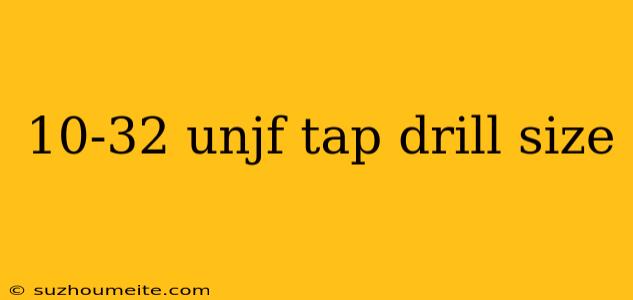10-32 UNF Tap Drill Size: A Comprehensive Guide
Introduction
When it comes to tapping threads in materials, having the right drill size is crucial to ensure a successful and precise process. One of the most common thread sizes is the 10-32 UNF (Unified National Fine), which requires a specific tap drill size to achieve optimal results. In this article, we'll delve into the world of 10-32 UNF tap drill sizes, exploring the recommended drill sizes, their applications, and tips for effective tapping.
What is a 10-32 UNF Thread?
Before we dive into the drill size, let's quickly discuss the 10-32 UNF thread itself. The 10-32 UNF thread is a type of screw thread commonly used in various industries, including aerospace, automotive, and construction. It's characterized by its fine threads, which provide a high thread density and offer excellent resistance to vibration and loosening.
Recommended Tap Drill Sizes for 10-32 UNF Threads
The recommended tap drill size for a 10-32 UNF thread varies depending on the material being tapped. Here are some general guidelines for different materials:
Steel and Stainless Steel: #21 (.1590 inches / 4.04 mm)
This drill size is suitable for most steel and stainless steel applications, providing an optimal balance between thread clearance and wall thickness.
Aluminum and Aluminum Alloys: #20 (.1610 inches / 4.09 mm)
For aluminum and its alloys, a slightly larger drill size is recommended to prevent the tap from binding and to ensure smooth thread formation.
Brass and Copper: #20 (.1610 inches / 4.09 mm)
Brass and copper require a similar drill size to aluminum, as these materials tend to be softer and more prone to galling.
Plastics and Composites: #21 (.1590 inches / 4.04 mm) or #20 (.1610 inches / 4.09 mm)
The choice of drill size for plastics and composites depends on the specific material and its properties. A smaller drill size may be required for more brittle materials, while a larger size may be suitable for more flexible materials.
Factors to Consider When Choosing a Tap Drill Size
While the recommended drill sizes above provide a general guideline, there are other factors to consider when selecting a tap drill size for 10-32 UNF threads:
- Material thickness: Thicker materials may require a larger drill size to prevent the tap from binding and to ensure enough thread clearance.
- Tap type: Different tap types, such as spiral point taps or flute taps, may require slightly different drill sizes.
- Thread length: Longer threads may require a smaller drill size to maintain thread integrity and prevent galling.
Tips for Effective Tapping with 10-32 UNF Threads
To achieve optimal results when tapping 10-32 UNF threads, follow these tips:
- Use a sharp, high-quality tap: A dull or low-quality tap can lead to thread damage, galling, or even tap breakage.
- Select the correct drill size: Choose a drill size that suits the material and application to ensure proper thread formation.
- Apply appropriate cutting fluid: Cutting fluid helps reduce friction, prevents overheating, and improves thread quality.
- Maintain proper tapping speed and pressure: Excessive speed or pressure can cause tap breakage or thread damage.
Conclusion
In conclusion, selecting the right tap drill size for 10-32 UNF threads is crucial for achieving precise and reliable thread formation. By considering the material, tap type, thread length, and other factors, you can ensure optimal results and minimize the risk of thread damage or tap breakage. Remember to always follow proper tapping techniques and use high-quality tools to guarantee successful thread tapping operations.
